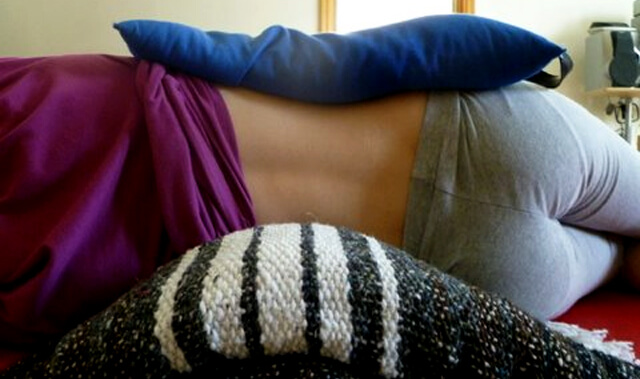
Scoliosis affects 2 to 4 percent of adolescents. Of these, 10% need medical treatment, and according to the medical community, the rest (90%) are just curved. Scoliosis can often cause pain and discomfort for someone’s entire adult life. This suffering may bring a person with scoliosis to a group yoga class. Is this a good idea? Well maybe.
Lets look at a couple of typical spinal curves.

As we can see, the spine is not straight which will cause muscles to be shortened on one side and lengthened on the other. In the S curve example we can see 2 areas of shortened and 2 areas of lengthened muscles.
I have some good news and some bad news.
The good news is that yoga can be very helpful for scoliosis. By lengthening the spine we decompress those tight shortened muscles. The curves in the spine can cause a very uneven situation from the feet to the head and many poses help decompress shortened areas up and down the body.
The bad news is that yoga poses that evenly stretch or strengthen a person without scoliosis will not do so in someone with this condition. So, for a person doing yoga poses for scoliosis with no modifications probably won’t work well for them. Why? Because the whole structure of the class is likely designed to bring symmetry to the body. But that won’t be the case for someone starting out with a fairly asymmetrical body—like a person with scoliosis.
The simplest way to think about modifying a yoga pose is to first understand that most symmetrical poses actually do one with a curved spine a disservice. Someone with scoliosis will need to work with their individual needs to achieve muscular balance. Asymmetrical poses are key to working with this kind of imbalance. Take side plank for example:
On 1 side, side plank will bring the spine and muscles towards alignment, however, side plank on side 2 will bring the spine into more asymmetry.
The other place we commonly see this problem in yoga class is overstretching already overstretched muscles. This can often feel good in real time but will make the condition worse over the long haul. Forward bends are a good example of a symmetrical stretch that should be modified. They lengthen erectors that are already long and not do much for the short structures. Over time, the long keep getting long, and the short don’t get much benefit, causing more asymmetry—the opposite of what we desire.
Asymmetrical forward bends or a slightly twisted forward bend (like Janushirshasana) will bring the structures more into alignment.
My suggestion is to have someone with scoliosis work privately with a Yoga Therapist and learn to modify all poses according to their back. Scoliosis and yoga therapy can work with the proper modifications. With this knowledge, one could take a yoga class safely and gain much benefit from these group practices. Otherwise we run the risk of unintentionally causing harm. If you’re a yoga practitioner with scoliosis, or a yoga teacher who wants more info about our online yoga therapy school, feel free to find me here for a consult to keep safe.
Om Shanti,
Brandt
Brandt talks about common questions applicants have about the Breathing Deeply Yoga Therapy Program. Tune in to get the full program details.
Friends in Yoga, The way we perceive the world is a curious thing. Is it on fire or getting better? Are we facing our challenges or shying away from them? Are we functioning from the present or some altered reality based on past experiences? The teachings tell us that reality is ultimately timeless. The vibration […]
There’s no doubt that yoga is gaining popularity, but you may be asking yourself, what is the most popular type of yoga? Where is each type most popular in the U.S. and around the world? And for those who are interested in trying it themselves, how can you practice these styles of yoga safely? For […]
Friends in Yoga, Sitting on a cushion, taking a yoga class, chanting a mantra before your morning coffee…no one would call these radical acts. They are small choices that we make to better ourselves. The motivation to practice often takes form by our desire to be healthier, to be more focused, to connect with our […]